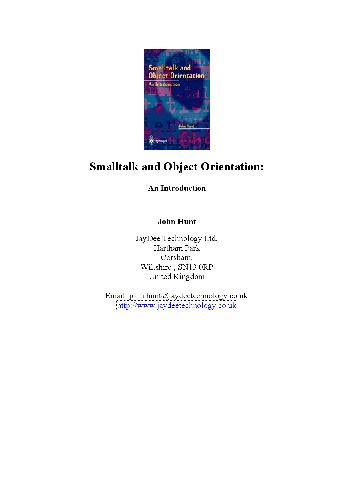Table of contents :
Content Summary……Page 2
Contents……Page 7
Introduction to Object Orientation……Page 13
1.2 Programming paradigms……Page 15
1.3 Revolution versus evolution……Page 16
1.4 History /pedigree of object oriented languages……Page 17
1.6 The four catechism of object orientation……Page 18
1.7 Encapsulation……Page 19
1.8 Inheritance……Page 20
1.10 Polymorphism……Page 22
1.11 Summary……Page 23
1.12 Further reading……Page 24
2.2 Terminology……Page 25
2.3 Types of hierarchies in object orientation……Page 26
2.4 Why bother?……Page 28
2.6 Summary……Page 32
2.8 Further reading……Page 33
3.2 The application: windscreen wipe simulation……Page 34
3.4 Identifying the objects……Page 35
3.5 Identifying the services/ methods……Page 36
3.7 Bringing it all together……Page 37
3.10 Further reading……Page 41
The Smalltalk Language……Page 42
4.2 What is Smalltalk……Page 44
4.4 History……Page 45
4.5 The Smalltalk environment……Page 47
4.6 Further reading……Page 52
5.2 The Workspace……Page 53
5.4 Notifiers……Page 54
5.5 Error processing……Page 55
5.6 Some Smalltalk……Page 56
5.7 Working with Smalltalk……Page 57
5.9 Further reading……Page 60
6.2 The basics of the language……Page 61
6.3 Classes……Page 62
6.4 Method definitions……Page 66
7.2 Numbers and operators……Page 69
7.3 Characters and strings……Page 70
7.5 Variables……Page 71
7.6 Messages and message selectors……Page 73
7.8 Further reading……Page 75
8.2 The class Person……Page 76
8.3 Defining methods……Page 77
8.4 Creating an instance……Page 80
9.3 Blocks……Page 81
9.4 Control structures……Page 83
10.1 Introduction……Page 86
10.2 The Collection class hierarchy……Page 87
10.4 The Collection class……Page 88
10.5 Bag……Page 89
10.6 Set……Page 90
10.7 OrderedCollection……Page 91
10.8 Stack and queue classes in Smalltalk……Page 92
10.10 Further reading……Page 94
11.2 SortedCollection……Page 95
11.4 Intervals……Page 96
11.6 Multi dimensional arrays……Page 97
11.7 Dictionaries……Page 98
11.8 Strings……Page 99
11.9 Iterating over collections……Page 100
11.10 Inserting into a collection……Page 101
11.11 Conversion……Page 102
12.3 The class definition……Page 104
12.4 The initialize- release protocol……Page 105
12.5 A class side method……Page 106
12.7 The accessing protocol……Page 107
12.8 The Financial Manager project……Page 109
13.2 Streams……Page 111
13.3 ASCII files……Page 112
13.4 The Binary Object Streaming Service……Page 114
13.5 Using files with the Financial Manager……Page 116
13.6 Summary……Page 117
14.2 The class Magnitude……Page 118
14.4 The class Time……Page 119
14.5 The class Character……Page 120
14.6 Further reading……Page 121
15.2 Errors and breakpoints……Page 122
15.3 File in/ file outs……Page 123
15.4 Change list……Page 125
15.5 Working with projects……Page 126
15.6 Summary……Page 128
Object Oriented Design……Page 129
16.3 Object oriented design methods……Page 131
16.5 The Booch method……Page 132
16.6 The Object Modeling Technique……Page 133
16.7 The Objectory method……Page 134
16.8 The Fusion method……Page 135
16.9 Summary……Page 136
17.1 Introduction……Page 137
17.2 The UML Infrastructure……Page 138
17.4 The object model……Page 139
17.5 Packages……Page 145
18.2 Dynamic modeling facilities……Page 147
18.3 Deployment diagrams……Page 152
18.4 Summary……Page 153
19.3 Analysis phase……Page 154
20.2 Dynamic models……Page 162
20.3 Design phase……Page 166
20.4 Implementation phase……Page 169
20.5 Summary……Page 170
21.2 Patterns and frameworks……Page 171
21.3 An introduction to HotDraw……Page 174
21.4 Where do you start?……Page 176
21.5 BoxDrawFigure……Page 177
21.6 Summary……Page 180
Testing and Style……Page 181
22.2 Why is testing object oriented systems hard?……Page 182
22.3 Inheritance……Page 184
22.5 Encapsulation……Page 185
22.6 Polymorphism……Page 187
22.7 Additional Smalltalk specific features……Page 188
22.9 Further reading……Page 189
23.1 Introduction……Page 190
23.3 System testing……Page 192
23.6 Further reading……Page 193
24.2 Variables……Page 195
24.3 Classes……Page 197
24.4 Methods……Page 200
24.5 Naming message protocols……Page 202
24.6 Further reading……Page 203
Graphical interfaces in Smalltalk……Page 204
25.2 The Perform mechanism……Page 205
25.3 The Dependency mechanism……Page 206
25.4 Summary……Page 212
26.2 The MVC architecture principles……Page 213
26.3 The MVC with the statement model……Page 218
26.4 Views and subviews……Page 220
26.5 The controller hierarchy……Page 221
26.7 Further reading……Page 222
27.2 What is a user interface builder?……Page 223
27.3 VisualWorks window painting tools……Page 224
27.4 Window specification and creation……Page 226
27.5 Application models versus domain models……Page 227
27.6 Defining a window’s functionality……Page 228
27.7 Initialization……Page 229
27.8 Resource Finder……Page 230
27.9 ValueHolders……Page 231
27.10 The onChangeSend: to: message……Page 232
27.11 Visual reuse……Page 233
27.12 Method of working with the UI builder……Page 234
27.13 Summary……Page 235
28.2 VisualOrganizer class……Page 236
28.3 The AddressBook class……Page 239
28.5 The visual Financial Manager application……Page 243
29.1 Introduction……Page 244
29.2 The custom view widget……Page 245
29.3 The structure of the application……Page 246
29.4 The interactions between objects……Page 247
29.5 The classes involved……Page 250
29.8 Further reading……Page 255
Further Smalltalk……Page 256
30.2 Why have automatic memory management?……Page 257
30.3 VisualWorks memory management……Page 258
30.5 Placing objects in PermSpace……Page 259
31.2 Concurrent processes……Page 261
31.3 Processes in Smalltalk……Page 262
31.4 A concurrent Smalltalk example……Page 264
31.5 Further reading……Page 267
32.2 What are classes?……Page 268
32.3 Classes and metaclasses……Page 269
32.4 ClassDescription and Behavior……Page 271
32.5 The metaclass concept goes recursive!……Page 272
The Future……Page 275
33.2 The Smalltalk language……Page 278
33.3 Object oriented development toolkits……Page 280
33.5 Object oriented databases……Page 281
33.7 Object technology: the next five years……Page 282
34.1 Basic syntax……Page 284
34.2 Literals and variables……Page 285
34.3 Classes and methods……Page 287
34.4 Blocks……Page 288
34.6 Collections……Page 289
Bibliography……Page 291
Index……Page 295
Smalltalk and Object Orientation – An Introduction
Free Download
Be the first to review “Smalltalk and Object Orientation – An Introduction” Cancel reply
You must be logged in to post a review.

Reviews
There are no reviews yet.